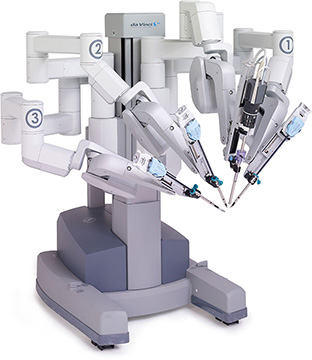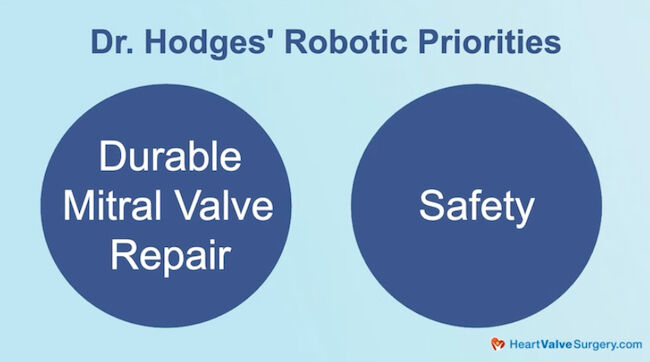Surgeon Q&A: Robotic Heart Surgery Conversion from Minimally-Invasive to Sternotomy
Written By: Allison DeMajistre, BSN, RN, CCRN
Medical Expert: Kevin Hodges, MD, Cardiac Surgeon, Northwestern Medicine, Chicago, Illinois
Reviewed By: Adam Pick, Patient Advocate, Author & Website Founder
Published: April 22, 2025
Minimally-invasive robotic surgery for heart valve repair and replacement can have significant benefits compared with conventional sternotomy, including less pain, shorter hospital stays, and a faster recovery.
It is important for patients to remember that robotic surgery is an open-heart procedure in which the surgeon uses very small ports to access and treat the defective valve through the ribs. While robotic approaches are safe and effective, there are risks and complications such as uncontrolled bleeding which may cause the surgeon to open the patient’s chest using a sternotomy.
We received a patient question on this topic from Bethany, who asked, “After a robot-assisted valve surgery starts, can excessive bleeding cause the robotic surgery to be aborted and a sternotomy approach be implemented?” To answer Bethany’s question, we asked Dr. Kevin Hodges, a leading minimally invasive surgeon specializing in robotic mitral valve repair at the Northwestern Medicine in Chicago, Illinois.
About Converting from Minimally Invasive to a Sternotomy During Surgery
Here are key learnings shared by Dr. Kevin Hodges:
- Surgeons discuss the possibility of the scenario for conversion prior to surgery. “This is a great question,” said Dr. Hodges. “It’s something we talk about every single time we see a patient in the clinic, and the answer is that the scenario is extremely uncommon. We tell patients it’s a less than one percent chance of changing from a robotic approach to a sternotomy or a conventional approach.”
 Da Vinci Heart Surgery Robot (Intuitive Surgical)
Da Vinci Heart Surgery Robot (Intuitive Surgical)
- Safety and good long-term outcomes are priorities. Dr. Hodges explained, “The reality is that our priorities are to, number one, get a really good mitral valve repair that’s going to last the patient for the rest of their life. Number two is to do that safely and have them leave the hospital without complications. So, if a scenario were to arise during surgery, for instance, bleeding that we couldn’t control with a robotic approach, we would change to a conventional approach or sternotomy of that’s what will keep the patient safe.”

Thanks Dr. Hodges and Northwestern Medicine!
On behalf of all the patients in our community, many thanks to Dr. Kevin Hodges for taking the time to share his clinical experiences and research with us. We also need to thank Northwestern Medicine for taking such great care of patients with heart valve disease!
Related Links:
- Video: The “5 Warning Signs” You May Need Heart Valve Surgery
- Download the free e-book: 6 Expert Tips for Heart Valve Patients
- Get the answer to 43 Patient Questions from Dr. Kevin Hodges
Keep on tickin,
Adam
P.S. For the deaf and hard-of-hearing members of our patient community, we have provided a written transcript of our interview with Dr. Hodges below.
Video Transcript:
Adam Pick: Hi everybody, it’s Adam with HeartValveSurgery. com, and today we’re in Chicago, Illinois. I’m thrilled to be joined by Dr. Kevin Hodges, who is a leading minimally invasive surgeon with a specialty in robotic mitral valve repair at the Northwestern Medicine Bloom Cardiovascular Institute.
Dr. Hodges, it is great to see you again and thanks for being with me today. Very happy to be here. Yeah. So we’re going to answer a patient question that just came in right in your specialty from Bethany. And she asks, “After a robot assisted mitral valve surgery starts… Can excessive bleeding cause the robotic surgery to be aborted and a sternotomy approach be implemented instead?”
Dr. Kevin Hodges: Thanks, Adam. This is a great question. It’s something we talk about every single time we see a patient in the clinic, and the answer is that that scenario is extremely uncommon. We tell patients it’s a less than 1 percent chance of changing from a robotic approach to a sternotomy or a conventional approach.
But the reality is that our priorities are to, number one, get a really good mitral valve repair that’s going to last the patient for the rest of their life, and number two, to do that safely and have them leave the hospital without any important complications. So if a scenario were to arise during surgery, For instance, bleeding that we couldn’t control with a robotic approach.
We would change to a conventional approach or sternotomy if that’s what it took to keep the patient safe.
Adam Pick: Great. Well, Bethany, I hope that helped you. I know it helped me and Dr. Hodges on behalf of the patients at HeartValveSurgery.com. Patients all over the world. Thanks to you and your team for all the great work you’re doing here at Northwestern Medicine.
Dr. Kevin Hodges: Thanks for being with me today. Thanks a lot.



